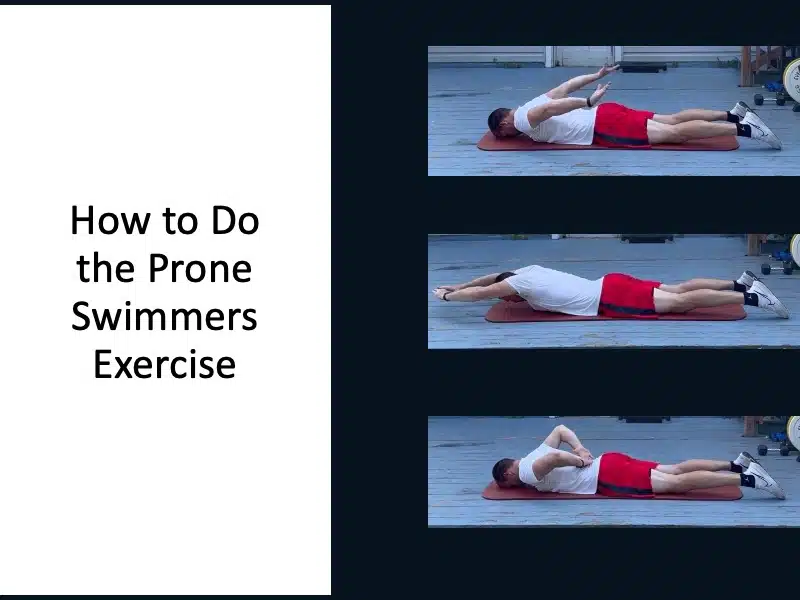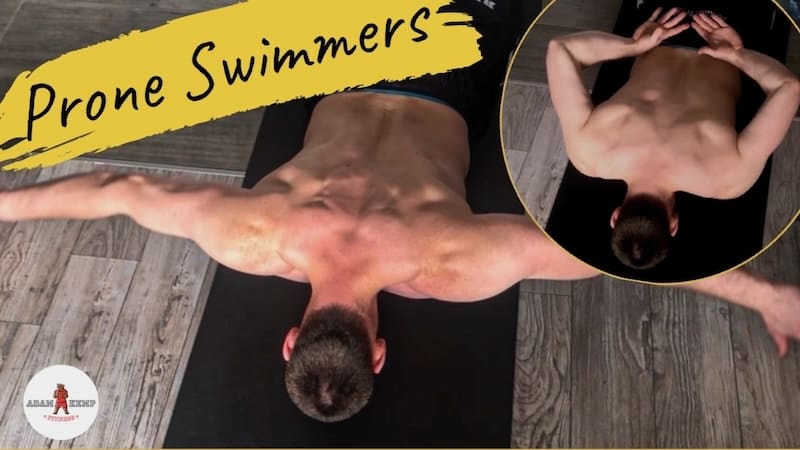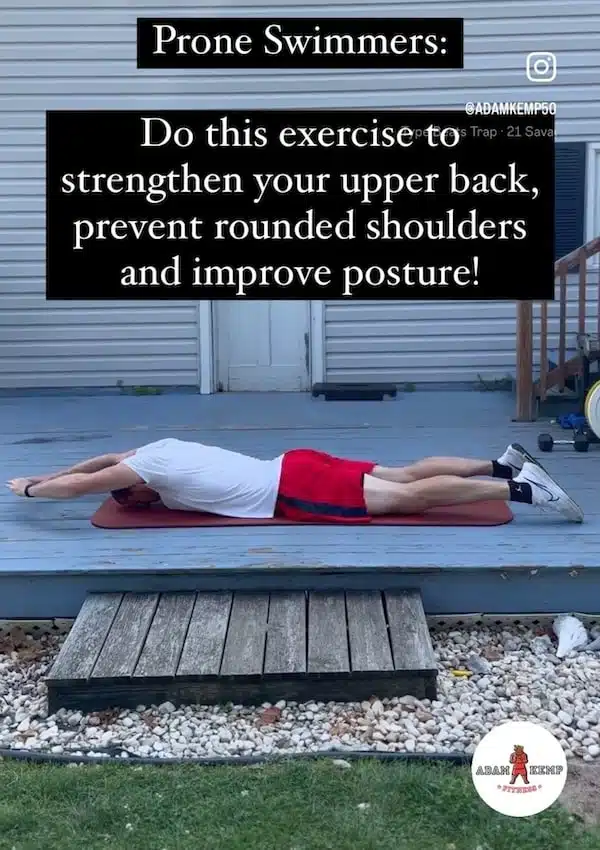Prone Swimmers Exercise: Benefits, Muscles Used & How to Do
The prone swimmers exercise is one of the most reliable and effective movements I use to support shoulder mobility, stability, and posture.
It’s a low-impact, bodyweight movement that works through a wide range of motion, making it a favorite in my rehab and prehab routines.
After tearing my labrum in college, my left shoulder lost a significant amount of mobility and stability.
Instead of surgically repairing the labrum, which is a long and difficult process, years of targeted training helped me rebuild strength, and the prone swimmers exercise has been vital in that recovery.
It remains a foundational part of my warm-ups, shoulder health routines, and general upper-body maintenance today.
From my experience, prone swimmers are one of the most highly effective movements for improving shoulder mobility, strengthening the upper back, and supporting improved posture.
Importantly, the prone swimmers exercise isn’t just for athletes.
Whether you’re someone who sits at a desk all day, struggles with poor posture, or wants healthier shoulders for lifting, swimming, or sports—prone swimmers offer a simple yet powerful solution.
Let’s break down how to do the prone swimmers exercise properly, the muscles it targets, and how to incorporate it into your training for long-term upper body health.
What is the Prone Swimmer Exercise?
The prone swimmers exercise is a bodyweight movement performed while lying face-down (prone), simulating the sweeping arm motion of a swim stroke.
It activates the stabilizing muscles of the shoulders and upper back, making it a top-tier mobility and corrective exercise.
This movement promotes healthy scapular function, improves posture, and strengthens underused muscles that are often neglected in traditional strength training routines.
Want to see exactly how to do the prone swimmers exercise?
Watch my YouTube video demonstrating the exercise below, and please consider subscribing for more! I regularly post new exercises, workout routines, injury prevention strategies, nutrition tips, and pro athlete insights that you can implement in your training!
How to Do the Prone Swimmers Exercise

Starting Position:
- Lie face-down on a mat with your arms extended overhead, palms facing down.
- Keep your forehead resting gently on the mat and legs relaxed.
Execution:
- Lift your arms slightly off the floor, engaging your shoulder blades and upper back.
- Sweep your arms outward and down in a wide arc toward your hips.
- As your arms pass your sides, rotate your palms to face up.
- Reverse the motion, bringing your arms back overhead while rotating your palms back down.
Important Cues:
- Engage Your Core: Keeping your core engaged helps protect your lower back and maintain stability throughout the exercise.
- Avoid Overarching the Lower Back: Focus on the shoulder and upper back movement to prevent strain in the lower back.
- Control Your Breathing: Inhale as you lift and sweep your arms, and exhale as you return to the starting position.
Recommended Sets & Reps:
- Progress Gradually: Start with a limited range of motion if necessary and build up as your shoulder mobility improves.
- Start with 2–3 sets of 8–12 reps, gradually increasing reps or range of motion as mobility improves.
What Muscles Do Prone Swimmers Work?
The prone swimmers exercise targets several key muscles responsible for shoulder function, posture, and scapular control:
- Rotator Cuff (Supraspinatus, Infraspinatus, Teres Minor, Subscapularis): These small but crucial muscles stabilize the shoulder joint and reduce the risk of injury.
- Lower Trapezius: Promotes scapular depression and supports an upright posture.
- Rhomboids: Help retract and stabilize the shoulder blades.
- Rear Deltoids: Work to counterbalance forward shoulder posture and assist with shoulder extension.
- Serratus Anterior: Activates during scapular upward rotation, aiding shoulder mechanics.
By recruiting these often undertrained muscles, prone swimmers promote healthier movement patterns and reduce muscular imbalances.
Benefits of Prone Swimmers
A strong, mobile, and stable shoulder joint is essential for everything from overhead lifts and throwing motions to basic daily activities like reaching and carrying.
The prone swimmers exercise specifically targets the often-overlooked stabilizer muscles in the upper back and shoulders, helping to improve joint control, reduce injury risk, and improve movement efficiency.
Whether you’re focused on performance, posture, or injury prevention, here’s why adding prone swimmers to your routine can help you get healthy shoulders.
Improves Shoulder Mobility
Prone swimmers move the shoulder joint through a wide range of motion, enhancing flexibility and reducing stiffness.
This dynamic movement keeps the shoulder joint well-lubricated and supports the long-term preservation of mobility.
It also retrains the scapular muscles to coordinate correctly, which is essential for smooth, pain-free overhead motion.
Regularly doing the prone swimmers exercise can significantly improve functional shoulder mobility for sports and daily activities.
Builds Upper Back Strength
The prone swimmers exercise fills a gap left by pressing- and pulling-dominant workouts that often neglect the mid and lower traps.
This exercise activates and utilizes the upper back muscles, particularly the rhomboids and lower trapezius, which support good posture and shoulder alignment.
Strengthening these muscles helps balance out overactive chest muscles, reducing strain on the shoulders.
This muscular balance is critical for injury prevention, especially for athletes and individuals who perform repetitive upper-body motions like swimming, throwing, or lifting.
Posture Support
By strengthening underactive muscles, prone swimmers can counteract the effects of rounded shoulders and improve overall posture.
Improved posture also reduces strain on the neck and upper back, preventing tension-related discomfort (Lynch et al., 2010).
As poor posture has been linked to reduced respiratory function and increased fatigue, correcting imbalances through targeted movements like prone swimmers can also improve energy and overall well-being.
The motion encourages thoracic extension, which supports a more upright and confident posture.
Promotes Shoulder Stability
Prone swimmers strengthen the stabilizing muscles around the shoulder, which can help prevent injuries and support shoulder health for high-performance activities.
Increased stability also improve control and precision in shoulder movements.
This is especially important for people recovering from injuries like rotator cuff tears or labrum damage, as it reinforces proper motor patterns.
By integrating the prone swimmers exercise consistently, you build a more resilient shoulder girdle capable of handling both dynamic and static demands.
How to Add Prone Swimmers to Your Workout Routine

To get the most from the prone swimmers exercise, consistency is key. This movement is easy to integrate into warm-ups, mobility sessions, or shoulder-specific training days—whether you’re at home, in a hotel room, or at the gym.
Prone swimmers pair well with other bodyweight shoulder mobility drills and resistance band exercises such as face pulls, band pull-aparts, or wall slides.
Prone swimmers are one of the most effective shoulder exercises at home, and can be combined with resistance band exercises or bodyweight movements to create home workouts for posture, mobility, and joint health.
These combinations help develop a well-rounded shoulder routine that targets strength, mobility, and posture simultaneously.
You can also complement prone swimmers with light dumbbell movements like the Around the World shoulder exercise, which challenges the shoulder joint through a circular range of motion, further enhancing control and mobility.
For best results, incorporate prone swimmers into your training 1–3 times per week, depending on your goals and current shoulder health.
- Beginner Recommendation: Start with 2–3 sets of 10–15 slow, controlled reps, focusing on quality movement and full range of motion.
- Progression Tip: Gradually increase reps or add light wrist weights for added resistance once you can perform the movement pain-free with solid form.
Include this exercise in your regular fitness plan to support stronger, more mobile shoulders, correct posture imbalances, and reduce your risk of injury during training or everyday life.
Make prone swimmers a non-negotiable part of your shoulder care strategy—and see the long-term difference in performance, comfort, and posture.
Final Thoughts: Is the Prone Swimmers Exercise Good for You?
Absolutely—the prone swimmers exercise is one of the most effective and accessible movements for improving shoulder mobility, posture, and joint stability.
Whether you’re building out a shoulder rehab program or just looking for smart, low-impact shoulder exercises at home, prone swimmers belong in your rotation. They’re easy to perform anywhere, require no equipment, and support long-term joint health when done consistently.
For anyone focused on mobility, performance, or posture correction, this exercise is a smart addition to the best home workouts or gym routines.
Frequently Asked Questions About the Prone Swimmers Exercise
Read Next: Best Shoulder Exercises for Climbing
This website does not provide medical advice. This website site does contain affiliate links, and purchases may earn a commission.
Read my Medical Disclaimer, Review Disclaimer, and Publishing Policies for more details. Use of this site indicates acceptance of these terms.



